M52: The Constellation Cassiopeia
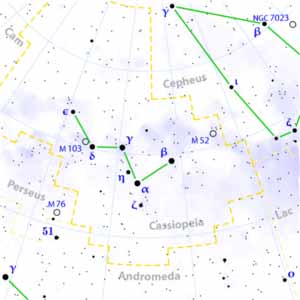
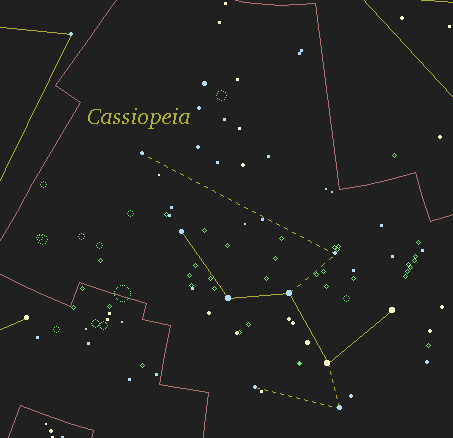
Cassiopeia is a northern constellation which greek mythology considered to represent a vain queen. It is one of the 88 modern constellations, and was also one of the 48 listed by Ptolemy.
Cassiopeia contains two stars visible to the naked eye that rank among the most luminous in the galaxy: p Cas and V509 Cas. The star n Cas is a nearby (19.4 ly) binary star comprising of a yellow Sun-like dwarf and an orange dwarf star.
This beautiful constellation at the edge of the Milky Way has definetely the shape of a "W". It is assiociated with the Perseus constellation family. Sweeping this region with binoculars (or even an opera glas) is rewarding (especially the region around delta Cas).
It is located between DECL=+50 and DECL=+60, RA=23h and RA=3h.
Cassiopeia is one of the stars that orbits the Polestar throughout the year. It is shaped like a W, with a makeup of five second- and third-magnitude stars, and has been a well-known constellation since ancient times. It contains about 370 variable stars and the large variety of clusters and binaries make it easily viewable with even a small telescope. It has been known in ancient Japan as the "Yamagata Star" and "Ikari Star."
In Arabian countries this constellation is called Caph, which is also the name of beta Cas.
After dark in Fall months, turn your back on the direction the sun went down and then shift a bit northward; you will be looking to the north-east. Starting straight overhead at the zenith, measure 2 palm-widths down towards the northeast. You will see there a group of five stars forming a "lazy M". This is the constellation Cassiopeia, or "Cassiopeia's Chair". You can see why it is also called the "Celestial M". As the night progresses, this northern constellation swings counterclockwise around the polestar Polaris and towards morning will become the "Celestial W".
The stars in Cassiopeia are all less than second magnitude brightness, but as they are visible at northern latitudes for the whole night all year, you may want to know them better. The brightest, Schedar, is a multiple star, pale rose overall and slightly variable, from 2.2 to 2.8 magnitudes, while the second brightest , Caph is a white star steady at 2.4 magnitudes.
When Caph is straight up towards the zenith from Polaris, it is celestial midnight, and this star is a 24-hour clock hand moving counter-clockwise around Polaris. The middle star, known as Gamma Cass for want of a historical name, is a brilliant white binary, magnitudes 2 and 11, the first star found with bright emission spectral lines. The last two stars, nearest Polaris, share one name, Ruchbah, from Arabic for "the knee".
Named Stars
- Shedir (Alpha Cas)
- Caph (Beta Cas)
- Ruchbah (Delta Cas)
- Segin (Epsilon Cas)
- Achird (Eta Cas)
- Marfak (Theta Cas)
- Marfak (Mu Cas)
Messier Objects
- M52 (open cluster)
- M103 (open cluster)
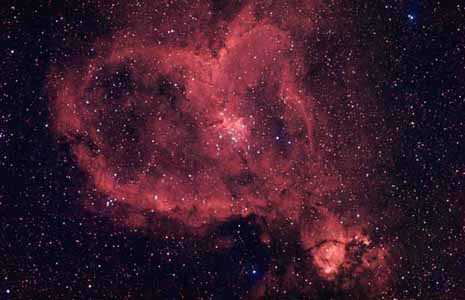
Cassiopeia - Heart Nebula 1C 1805
Mythology
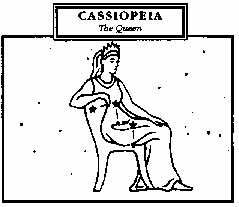
Cassiopeia was a queen and the wife of Cepheus, the Ethiopian king of Joppa (now known as Jaffa, in Israel), and the mother of Andromeda. The queen was both beautiful and vain, and the story of how her vanity caused great distress is told in relation to the constellation Andromeda.
After promising her daughter in marriage to Perseus, Cassiopeia had second thoughts. She convinced one of Poseidon's sons, Agenor, to disrupt the ceremony by claiming Andromeda for himself. Agenor arrived with an entire army, and a fierce struggle ensued.
In the battle Cassiopeia is said to have cried "Perseus must die". At any rate it was Perseus who was victorious, with the help of the Gorgon's head.
Perseus had recently slain Medusa, the Gorgon, and had put its head in a bed of coral. He retrieved the head and waved it in midst of the warring wedding party, instantly turning them all to stone. In the group was both Cepheus and Cassiopeia.
A contrite Poseidon put both father and mother in the heavens. But because of Cassiopeia's vanity, he placed her in a chair which revolves around the Pole Star, so half the time she's obliged to sit upside down.
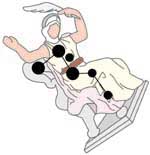
News Articles
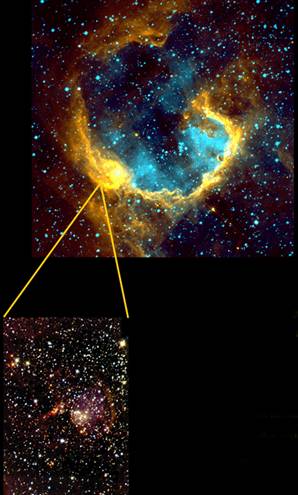
MSNBC - November 15, 2005
Some regions in space are especially good at creating massive stars. Astronomers know the recipe for creating a star in one of these stellar nurseries calls for hydrogen gas, dust and some amount of heat and gravity, but they still don't know quite how all the parts come together or what triggers the event.
Several theories have been proposed.
One predicts that low-mass stars accrete surrounding material.
Another calls for the forceful combination of two protostars.
A third, called the "collect-and-collapse" model, says that a parent massive star influences the formation of second-generation stars.
Now, a collection of images presented by astronomers at the Laboratoire d'Astrophysique de Marseille in France provides the most complete and detailed evidence supporting the collect-and-collapse model, without ruling out the other models.
How it works
Collect-and-collapse works like this: When a star reaches a mass eight times greater than the sun, it begins to emit intense amounts of energy in the form of ultraviolet photons, triggering a series of events that lead to the formation of massive stars.
These highly energized photons react with surrounding gas molecules, and the region near the star becomes filled with ionized hydrogen gas. Once a region is acting this way, it becomes known as an HII region.
This ionized gas inside an HII region is hot. Like all hot things, it expands, and it does so continuously because the area outside the region is much cooler.
As the region expands, dust and gas begin to collect along the outer edges, like a broom sweeping across a dirty floor.
After a while, gravitational instabilities cause the dust and gas to fragment into clumps, which are large enough to collapse and form second-generation stars.
While many scientists subscribed to the collect-and-collapse model, no strong evidence existed until the release of this set of images of galactic HII region RCW 79, about 14,000 light-years from Earth.
This collection of images gives the most complete look into a "triggered" star-forming region, clearly depicting each of its characteristics.
In the most recently released set of images, an orange version shows the dust shell that surrounds the HII region RCW 79. The blue image highlights ionized hydrogen, clearly showing that it fills the inside of the region. The yellow represents the condensation of cold dust in the outer shell of the region.
Inside look
Using the mid-infrared Spitzer observations from the GLIMPSE survey, the team has identified newly formed, second-generation massive stars associated with the main condensations.
One of these second-generation stars has evolved enough to begin emitting ultraviolet photons itself and could give rise to a compact second-generation HII region.
Based on the locations and morphological relations between these structures, the team concluded that these observations agreed very well with the collapse-and-collect process and that it is the main trigger for massive star formation along the borders of this region.
These images were produced by Annie Zavagno and Lise Deharveng of the Laboratoire d'Astrophysique de Marseille using several telescopes: NASA's Spitzer Space Telescope, the SuperCOSMOS Sky Survey, the ESO Swedish Submillimetre Telescope and the ESO-New Technology Telescope.
Other Articles
Cassiopeia A: Dead But Not Quiet Space.com - June 10, 2005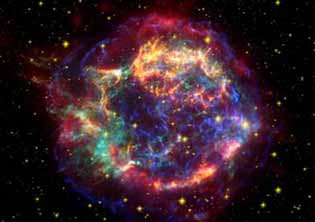
This composite false-color image shows the Cassiopeia A supernova remnant as seen by NASA's great observatories: Hubble in visible light (yellow), Chandra in X-rays (blue), and Spitzer in infrared (red).
Light echo spreads out from supernova remnant MSNBC - June 10, 2005
An echo has been detected around a star that died 325 years ago. The reverberation - emanating out in light, not sound waves - implies that the stellar remnant let out a burst of energy 50 years ago.
The dead star in question is Cassiopeia A, whose explosion or supernova was witnessed by Tycho Brahe in 1572. Situated 10,000 light years away, astronomers believe a dense neutron star is all that is left of the original star.
This neutron star remnant was thought to be resting in peace, that is, until this recent discovery of a light echo in infrared images taken by NASA's Spitzer Space Telescope.
No comments:
Post a Comment